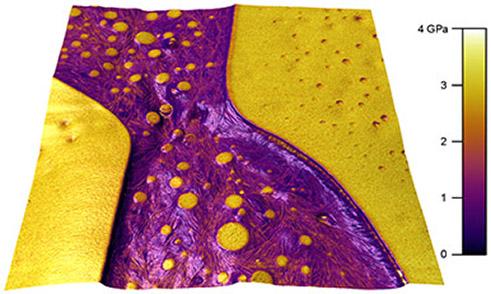AFM Systems
AFM Accessories
Learning
Contact Us

Polymers are ubiquitous in everyday life and the subject of much materials research. Polymer properties are varied and atomic force microscopy is an excellent tool to study them on many levels. In addition to accurate measurement of polymer film topography, the wide range of AFM techniques available on Asylum Research instruments allows for study of diverse polymer properties ranging from molecular chain arrangement in crystallites to domain modulus and conductivity.
Ask an AFM expert for more information"Persistence length of poly(vinyl amine): Quantitative image analysis versus single molecule force response," S. Kozhuharov, M. Radiom, P. Maroni, and M. Borkovec, Macromolecules 51, 3632 (2018). https://doi.org/10.1021/acs.macromol.8b00834
"One‐step synthesis and enhanced thermoelectric properties of polymer‐quantum dot composite films," W. Shi, S. Qu, H. Chen, Y. Chen, Q. Yao, and L. Chen, Angew. Chem. Int. Ed. 57, 8037 (2018). https://doi.org/10.1002/anie.201802681
"Morphological explanation of high tear resistance of EPDM/NR rubber blends," C. Goegelein, H. J. H. Beelen, and M. van Duinc, Soft Matter 13, 4241 (2017). https://doi.org/10.1039/c7sm0264e
"Real-time atomic force microscopy imaging of block copolymer directed self assembly," J. Raybin, J. Ren, X. Chen, R. Gronheid, P. F. Nealey, and S. J. Sibener, Nano Lett. 17, 7717 (2017). https://doi.org/10.1021/acs.nanolett.7b03881
"Stem‐cell clinging by a thread: AFM measure of polymer‐brush lateral deformation," M. K. Gunnewiek, S. N. Ramakrishna, A. Di Luca, G. J. Vancso, L. Moroni, and E. M. Benetti, Adv. Mater. Interfaces 3, 1500456 (2016). https://doi.org/10.1002/admi.201500456
"Elastic and viscoelastic characterization of inhomogeneous polymers by bimodal atomic force microscopy," H. K. Nguyen, M. Ito, and K. Nakajima, Jpn. J. Appl. Phys. 55, 08NB06 (2016). https://doi.org/10.7567/jjap.55.08nb06
"Bimodal poly(ethylene-cb-propylene) comb block copolymers from serial reactors: Synthesis and applications as processability additives and blend compatibilizers," A. H. Tsou, C. R. López-Barrón, P. Jiang, D. J. Crowther, and Y. Zeng, Polymer 104, 72e82 (2016). http://dx.doi.org/10.1016/j.polymer.2016.09.088
"Nano-rheology of hydrogels using direct drive force modulation atomic force microscopy," P. C. Nalam, N. N. Gosvami, M. A. Caporizzo, R. J. Composto, and R. W. Carpick, Soft Matter 11, 8165 (2015). https://doi.org/10.1039/c5sm01143d
"Thermoplastic elastomers of alloocimene and isobutylene triblock copolymers," J. Roh, D. Roy, W. Lee, A. Gergely, J. Puskas, and C. Roland, Polymer 56, 280 (2015). https://doi.org/10.1016/j.polymer.2014.11.015
"Fast nanomechanical spectroscopy of soft matter," E. T. Herruzo, A. P. Perrino, and R. Garcia, Nat. Commun. 5, 3126 (2014). https://doi.org/10.1038/ncomms4126
"Measuring the loss tangent of polymer materials with atomic force microscopy based methods," D. G. Yablon, J. Grabowski, and I. Chakraborty, Meas. Sci. Technol. 25, 055402 (2014). https://doi.org/10.1088/0957-0233/25/5/055402
"Resolving sub-molecular binding and electrical switching mechanisms of single proteins at electroactive conducting polymers," A. Gelmi, M. J. Higgins, and G. G. Wallace, Small 9, 393 (2013). https://doi.org/10.1002/smll.201201686
“Improved electrical and flow properties of conductive polyolefin blends: Modification of poly(ethylene vinyl acetate) copolymer/carbon black with ethylene–propylene copolymer,” T. Gkourmpis, C. Svanberg, S. K. Kaliappan, W. Schaffer, M. Obadal, G. Kandioller, and D. Tranchida, Eur. Polym. J. 49, 1975 (2013). https://doi.org/10.1016/j.eurpolymj.2013.03.003
"Nano-scale temperature dependent visco-elastic properties of polyethylene terephthalate (PET) using atomic force microscope (AFM)," C. A. Grant, A. Alfouzan, T. Gough, P. C. Twigg, and P. D. Coates, Micron 44, 174 (2013). https://doi.org/10.1016/j.micron.2012.06.004
"Measuring the interaction between ions, biopolymers and interfaces — one polymer at a time," S. Kienle, T. Pirzer, S. Krysiak, M. Geisler, and T. Hugel, Faraday Discuss. 160, 329 (2013). https://doi.org/10.1039/c2fd20069d
"Poly (acrylamide) films at the solvent-induced glass transition: Adhesion, tribology, and the influence of crosslinking," A. Li, S. N. Ramakrishna, E. S. Kooij, R. M. Espinosa-Marzal, and N. D. Spencer, Soft Matter 8, 9092 (2012). https://doi.org/10.1039/c2sm26222c
"Signature of hydrophobic hydration in a single polymer," I. T. S. Li and G. C. Walker, Proc. Natl. Acad. Sci. U.S.A./em> 108, 16527 (2011). https://doi.org/10.1073/pnas.1105450108
“High-resolution studies of domain switching behavior in nanostructured ferroelectric polymers,” P. Sharma, T. J. Reece, S. Ducharme, and A. Gruverman, Nano Lett. 11, 1970 (2011). https://doi.org/10.1021/nl200221z
"Improved performance of polymer bulk heterojunction solar cells through the reduction of phase separation via solvent additives," C. V. Hoven, X.-D. Dang, R. C. Coffin, J. Peet, T.-Q. Nguyen, and G. C. Bazan, Adv. Mater. 22, E63 (2010). https://doi.org/10.1002/adma.200903677
"Self-assembling polystyrene-block-poly(ethylene oxide) copolymer surface coatings: Resistance to protein and cell adhesion," P. A. George, B. C. Donose, and J. J. Cooper-White, Biomaterials 30, 2449 (2009). https://doi.org/10.1016/j.biomaterials.2009.01.012
"Nanoscale thermal–mechanical probe determination of 'softening transitions' in thin polymer films," J. Zhou, B. Berry, J. F. Douglas, A. Karim, C. R. Snyder, and C. Soles, Nanotechnology 19, 495703 (2008). https://doi.org/10.1088/0957-4484/19/49/495703
"Nanoindentation of shape memory polymer networks," E. Wornyo, K. Gall, F. Yang, and W. P. King, Polymer 48, 3213 (2007). https://doi.org/10.1016/j.polymer.2007.03.029
"Time-resolved electrostatic force microscopy of polymer solar cells," D. C. Coffey and D. S. Ginger, Nat. Mater. 5, 735 (2006). https://doi.org/10.1038/nmat1712
"Functional polymers: scanning force microscopy insights," P. Samorì, M. Surin, V. Palermo, R. Lazzaroni, and P. Leclère, Phys. Chem. Chem. Phys. 8, 3927 (2006). https://doi.org/10.1039/b607502a
"Using AFM force–distance curves to study the glass-to-rubber transition of amorphous polymers and their elastic–plastic properties as a function of temperature," B. Cappella, S. K. Kaliappan, and H. Sturm, Macromolecules 38, 1874 (2005). https://doi.org/10.1021/ma040135